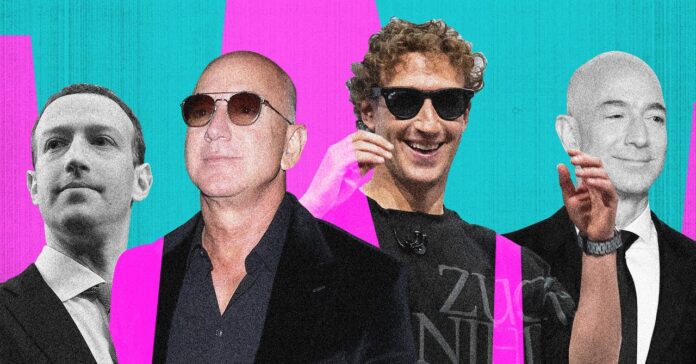In an industry that prides itself on disruption, dressing down became its own kind of dominance, while also reflecting the tech ideology of the time: Innovation over tradition, efficiency over excess, and—at least in its early days—a belief that technology existed to serve people, not just profit from them.
Indeed, in the early 2000s and 2010s, tech’s biggest names presented themselves as visionaries on a mission to democratize access, improve lives, and build a better future. The industry positioned itself as an antidote to Wall Street’s greed, and the seemingly casual uniform of t-shirts, hoodies, and sneakers reinforced that distinction. Tech leaders weren’t flashy bankers in tailored suits; they were problem solvers, engineers, and idealists, working toward a utopian vision of progress.
“Zuckerberg’s style shift says something about a specific group of American billionaires who are aligning themselves with what looks to be a new political order within the United States,” says Dr Wild. “These moguls control multinationals, which include Meta, Google, Amazon and Uber, that have an extraordinary capacity to influence people’s decision-making, and who are consequently prime figures for politicians to moderate.” While the Biden administration did this via the judicial arm of government and legal courts, it appears President Trump seems inclined to handle these men through his personal court, where they are required to seek his approval.
“We saw this at Trump’s presidential inauguration,” says Dr Wild, “where the invitees constituted a who’s who of American tech billionaires. For me, there are strong parallels with medieval royal courts, where members of the aristocracy competed among themselves, often in what they wore and how they consumed, for the attention and patronage of the ruler. Within America today, these men seem less concerned about their perception among the public, and far more concerned about how they appear to one another, and Trump.”
For now, some tech bros—Sam Altman included—are still clinging to their tees and action slacks, but how long before their look evolves to match the growing power they wield? OpenAI, after all, seems to be getting darker by the day. And then there’s Sundar Pichai, the quiet architect of Google’s AI empire, whose fashion may not be making headlines (yet), but whose policies certainly are. Under his watch, Alphabet just scrapped its long-standing promise not to develop AI for weapons or surveillance.
So what’s next? A titanium Richard Mille built for billionaires with defense contracts? A bespoke Brunello Cucinelli cashmere sweater embazoned with “In AI We Trust”? Pichai’s already ditched the New Balance memo for those Lanvin sneakers, with hype footwear a previous gateway drug for billionaires (Zuck famously has a penchant for Adidas 4DFWD x Strung trainers). If the new tech dress code is all about signaling dominance, surely it won’t be long before Pichai and Altman follow suit. Because in Silicon Valley, power isn’t just wielded—now it’s worn.
The Impunity of Reinvention
The curious thing? Few are questioning Mark Zuckerberg’s transformation. Most commentary fixates on the what and how—his sculpted physique, designer accessories, and combat-ready aesthetic—rather than the why. “This emphasises the persistence of gender inequalities. When Kamala Harris was running for office, her aesthetic choices were scrutinised relentlessly. Yet Zuckerberg’s evolution is met with curiosity rather than critique. It highlights the impunity with which powerful men can reinvent themselves,” says Dr Wild.
For Zuckerberg, the shift from awkward tech nerd to combat-trained, physically imposing leader mirrors the broader trajectory of Silicon Valley itself. The archetype of the hoodie-clad disruptor has been replaced by something more militarized, more overtly aggressive. The new tech oligarchy isn’t just about controlling perception; it’s about controlling entire industries—perhaps even countries. And increasingly, it operates beyond the reach of traditional accountability.

